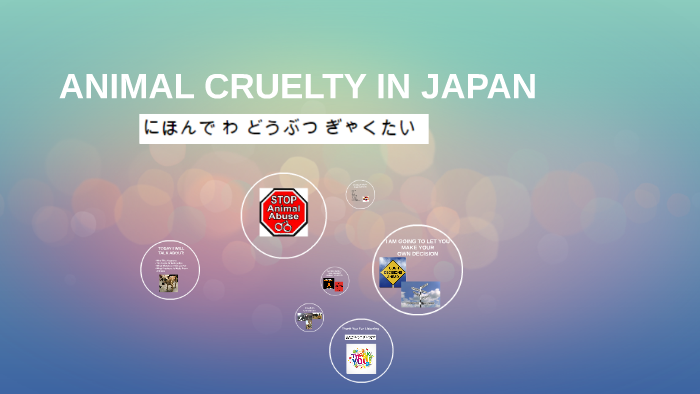Japan, a nation known for its rich tapestry of culture, innovation, and natural beauty, harbors an unsettling paradox in the realm of animal welfare. As we delve into the question: “Is animal cruelty legal in Japan?” we must navigate the intricate landscape of laws, societal attitudes, and the gaps that lie within the framework of animal protection. This inquiry not only compels examination of the legal statutes but also necessitates a broader understanding of cultural practices and historical contexts.
At first glance, Japan does possess some legislation aimed at protecting animals. The main legal framework is encapsulated in the Act on Welfare and Management of Animals, enacted in 1973 and revised multiple times since. This statute is designed to safeguard domestic animals and prevent their abuse and neglect. However, despite the existence of these laws, a significant challenge looms over the effectiveness of this legislation. Where might the loopholes be, and how do they affect the treatment of animals?
One of the most glaring deficiencies within Japan’s animal welfare laws is the ambiguous definition of what constitutes cruelty. While neglect and mistreatment are ostensibly prohibited, the law lacks specificity regarding the physical and psychological torment that animals endure. For instance, the act of euthanizing a pet may not necessarily be classified as cruel, even if executed under dubious circumstances. Thus, the lack of precise legal delineations can lead to inconsistencies in enforcement and a culture of impunity for offenders.
Moreover, the limited scope of protection primarily focuses on domesticated animals, leaving a vast majority—including wildlife—vulnerable to various forms of cruelty. In a country where certain traditional practices involving animals persist, such as ‘fishing contests’ or ‘live seafood restaurants,’ one must question how the prevailing cultural attitudes influence legal protections. Are these practices indicative of a wider acceptance of animal suffering?
Furthermore, the enforcement mechanisms established to combat animal cruelty are often inadequate. Local authorities and animal control agencies are typically underfunded and lack the resources required to effectively monitor, investigate, and prosecute cases of abuse. The result is a disheartening landscape where instances of mistreatment often go unchallenged, fostering an environment where cruelty can flourish unchecked. Are the laws simply words on paper without the strength to provoke real change?
Japan’s societal attitudes towards animals also merit scrutiny. While many citizens express a fondness for pets, viewing them as family members, these sentiments are not universally embraced. The notion of animals as objects rather than sentient beings still permeates segments of the culture. This worldview is reflected in various aspects of daily life, from media portrayals of animals to the normalization of certain exploitative practices. If societal empathy for animals does not align with the intent of legal protections, how can one expect substantial legislative change?
In tackling the question of animal cruelty in Japan, it is essential to recognize the role of advocacy groups and activists. Numerous organizations are striving to bridge the gaps in animal welfare by raising awareness, lobbying for stricter laws, and pushing for a transformation in cultural perceptions. The work of these individuals is indispensable; they serve not just as voices for the voiceless, but also as catalysts for societal change. Yet, how effective can they be in overcoming deeply entrenched attitudes?
One cannot ignore the juxtaposition between Japan’s international image as a progressive nation and its lagging animal welfare legislation. For instance, in contrast to countries with robust animal protection laws, Japan’s comparatively permissive stance can appear alarming. What does this say about the nation’s priorities, and how does it affect its global standing?
Moreover, a striking challenge lies within the confines of the Japanese government’s response to international scrutiny. As global conversations surrounding animal rights intensify, there is mounting pressure for reform. However, policymakers often approach these calls with caution, wary of alienating cultural practices that, although contentious, are deeply rooted in tradition. How then can Japan reconcile its cultural heritage with the moral imperatives of animal welfare?
Despite these obstacles, there is a silver lining. With the growing awareness of animal welfare issues globally, the momentum for change in Japan appears to be slowly gaining strength. The advent of social media has provided a platform for activism, empowering citizens to share abuses and injustices that may have once gone unnoticed. Increased exposure to international animal welfare standards could serve as a transformative force, nudging Japan toward adopting more stringent protections.
In summary, while Japan has established some guidelines to protect animals, the question remains: is animal cruelty effectively deterred in practice? The legal provisions are laden with ambiguities, enforcement remains lackluster, and cultural perceptions play a pivotal role in shaping the treatment of animals. Nonetheless, as the tide of global awareness rises, so too does the potential for progressive reform. It is imperative we continue to advocate for the voiceless, urging Japan to align its laws with the evolving understanding of animal rights. Until substantial changes occur, one cannot definitively claim that animal cruelty is nothing more than a relic of the past.









